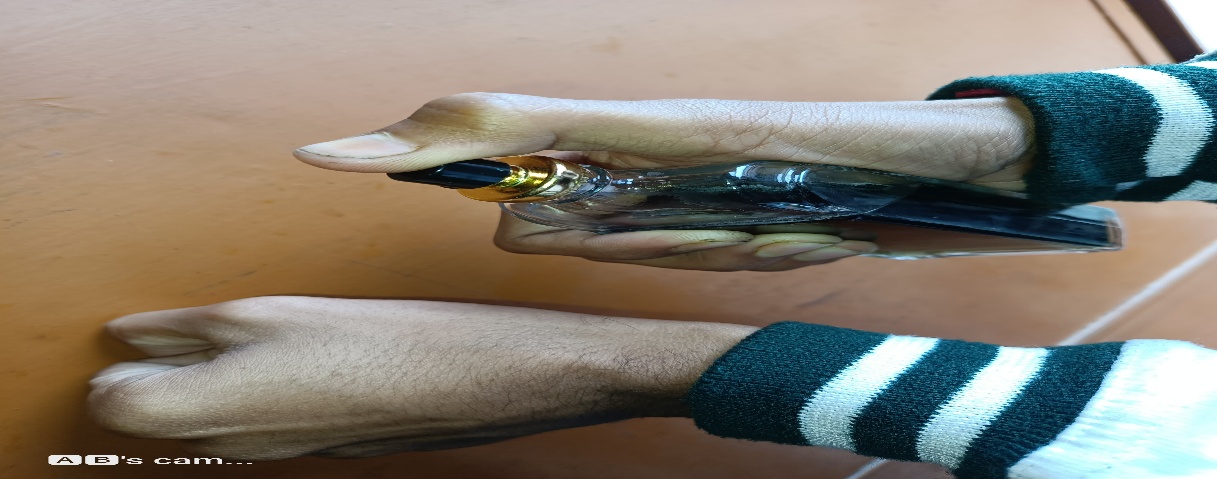Ijraset Journal For Research in Applied Science and Engineering Technology
- Home / Ijraset
- On This Page
- Abstract
- Introduction
- Conclusion
- References
- Copyright
Formulation & Evaluation of Perfume based on Herbal Oils: A Review
Authors: Shajeel Ahmad, Vishwajeet Pandey, Shashank Singh, Garima Pandey, Allena , Devratan , Himanshu Singh, Dr. Alok Kumar Shukla
DOI Link: https://doi.org/10.22214/ijraset.2025.66590
Certificate: View Certificate
Abstract
Essential oil from lavender flowers and tea tree leaves was extracted using the processes of distillation, maceration, and steam distillation. Perfume extraction is the process of removing aromatic components from basic materials. In order to create a natural perfume, this study set out to extract essential oils from particular fragrant and therapeutic plants, flowers, and leaves. Aromatic essential oils are derived from plants in the Myrtaceous family, such as lavender and Melaleuca alternifolia. Aromatic essential oils are mostly composed of linalool, 1,8-cineole, linalyl acetate, ?-terpinene, ?-terpinene, ?-terpineol, terpinen-4-ol, p-cymene, and ?-pinene. Numerous studies have also been conducted to ensure that it is safe for human use and to lessen the likelihood of instability and discomfort. One of lavender\'s main advantages is its ability to encourage calm without making people feel sleepy. By regulating the body\'s fight-or-flight reaction, lavender not only promotes mental serenity but also lowers anxiety. Lavender essential oil has demonstrated efficacy in lowering stress, while tea tree oil has relaxing properties that aid in relaxation, stress relief, and improved sleep quality. Research has shown that aromatherapy can help reduce tension, and tea tree oil is a very useful essential oil for this purpose. To create a natural scent for body splashes or air fresheners, you can substitute some essential oils for others. However, it is essential to perform more toxicological analyses on the product before proceeding.
Introduction
I. INTRODUCTION
The use of perfumes goes back thousands of years. The Egyptians used gums, resins, and botanicals in their sacred ceremonies. In order to enhance physical beauty and create a cosier ambiance in homes and public spaces, scented materials were used over time. Fragrances are acknowledged as commonplace aspects of our everyday lives. Many people think that wearing a fragrance can improve their mood. This is probably because of the connections between aroma and memory that have been discovered, as well as the fact that some perfumes have been shown to alter moods and even ease anxiety and stress. Perfumes are compounds that emit and disperse a pleasing, fragrant perfume. They are made up of synthetic blends of essential oils and aromatic compounds. Before the seventeenth century, perfumes were usually made from natural aromatic oil (Yogesh et al, 2023). Both natural fragrance compounds generated from plants or animals and manufactured scented molecules used in perfumery are referred to as aroma chemicals. (Surburg et al, 2006). The amount and quality of essential oils that are extracted from the whole aromatic plant or only a piece of it depend on the extraction technique, which is usually steam distillation. In order to create a nice aroma for the body, objects, and settings, sweet-smelling essential oils are combined with additional aroma compounds, solvents, and fixatives to create perfume. People have applied perfume since the dawn of written history in an attempt to mimic the soothing aromas of nature and cover up or enhance their odour. (Tilahun & colleagues, 2021). A perfume is a concoction of fragrant essential oils, smell compounds, solvents, and fixatives that is typically in liquid form. It is used to add a pleasing scent to food, the human body, animals, objects, and living areas. Substances known as perfumes emit and disperse a pleasing, aromatic aroma. They are made up of synthetic blends of essential oils and aromatic compounds. According to a 1945 remark by 1939 Chemistry Nobel Laureate Leopold Ruzicka, "Perfumery has had a significant influence on the development of organic chemistry as regards methods, systematic classification, and theory, right from the earliest days of scientific chemistry up to the present time."
Modern perfumery began in the late 1800s when commercial synthesis of aroma compounds like coumarin and vanillin allowed for the development of fragrances with aromas that were previously difficult to produce with only natural aromatics. (Joy PP et al, 2001).
II. HISTORY
Perfumare, which translates as "to smoke through" in Latin, is where the word perfume comes from. Perfumery, or the art of making fragrances, has roots in Mesopotamia, ancient Egypt, the Indus Valley Civilisation, and most likely ancient China.
It was further refined by the Romans and Muslims. Perfumery and aroma were a component of the Indus civilisation (3300–1300 BC) in the Indian subcontinent. In 2003, archaeologists think they discovered the oldest surviving scents in the world near Pyrgos, Cyprus. The smells date back more than 4,000 years. It was considerably more developed by the Muslims and Romans. Perfumery and aroma were part of the Indus civilisation (3300–1300 BC) in the Indian subcontinent. Near Pyrgos, Cyprus, in 2003, archaeologists found what they believe to be the world's oldest surviving odours. The smells have existed for about 4,000 years.
The Greek National Archaeological Museum's centenary exhibition "Countless Aspects of Beauty" featured a reconstruction of the vintage perfume rose, or "Rodo," in May 2018. This made it possible for tourists to use their sense of smell to experience antiquity. The Book of the Chemistry of Distillations and Perfume, written by the ninth-century Arab scholar Al-Kindi (Alkindus), had more than a hundred recipes for fragrant oils, salves, aromatic waters, and surrogate pharmaceuticals for fake versions of costly drugs. Along with information on the equipment required to produce perfumes, such as the alembic, the book also contained 107 recipes and techniques for making perfumes. Distillation is currently the most widely used technique for extracting oils from flowers; it was initially created by the Persian scientist Ibn Sina, also referred to as Avicenna. First, he used the rose for his experiments. Before his discovery, strong mixtures of oil and crushed flowers or plants were used to make liquid scents. Rose water immediately became popular because it was more gentle. Aromatic plant cultivation reached Sicily's Grasse district in France and Calabria in Italy by the end of the seventeenth century, supplying raw materials for the expanding perfume industry. The evolution of the raw materials and distillation technology had a significant influence on European science and perfumery. France and Italy are the hubs of European perfume design and commerce. (Mookherjee et al, 1990).
III. MATERIAL AND METHODS
A. Selection of Plants
1) Lavender Plant
A beautiful plant for the garden, lavender (Lavandula officinalis Chaix.) belongs to the Lamiaceae family. Its components include linalyl acetate, camphor, terpinen-4-ol, beta-ocimene, 1,8-cineole, and linalool. The therapeutic actions and concentrations of certain elements vary depending on the species. Massages that depress the central nervous system (CNS) are known to maximise and improve the skin's ability to absorb linalyl and linalyl acetate. Although linalyl acetate has obvious narcotic properties, linalalool has a relaxing impact. These two effects, which also enhance wellbeing, increase mental alertness, and reduce anxiety and aggression, may be the reason for its use in lavender cushion anxiety patients who have sleep pattern issues. However, it is currently uncertain what exact mechanisms underlie lavender oil's antibacterial and antifungal properties against a variety of pathogens, especially when medications are ineffectual. It has a long history of efficacy in aromatherapy for a number of ailments, such as burns, abrasions, stress, headaches, skin problems, sore muscles, and immune system stimulation. Additionally, it is known to encourage the production of new cells. This oil demonstrated encouraging outcomes when used to treat primary dysmenorrhea in a double-blind, randomised clinical trial.
(Jasmanium et al, 2011).
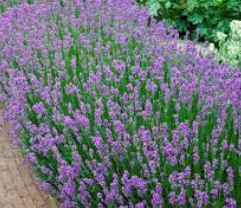
Fig.1 - Lavandula officinalis
2) Tea tree plant
The shrub known as the tea tree (Melaleuca alternifolia Cheel) grows in swampy places. It belongs to the Myrtaceae family and features needle-like leaves along with yellow or purple blooms. It is grown on plantations because of its commercial value.
Terpinen-4-ol, an alcoholic terpene with a clean, musty aroma, is its main component. The antiviral action is due to alpha-sabine, which also has antibacterial and antifungal qualities. Terpinen-4-ol has an immune-stimulating impact, while cineole is said to have antimicrobial qualities. The tea tree itself possesses antiviral, antibacterial, anti-inflammatory, immune-stimulating, and insecticidal properties. Aromatherapy uses a mixture of blue gum, lemon, eucalyptus, clary sage, lavender, ginger, rosemary, and Scotch pine to treat a number of ailments. Burns, blisters, herpes, abscesses, acne, cold sores, dandruff, and bugs. It must also be certified to treat a range of respiratory disorders, such as TB, bronchitis, asthma, coughing, and whooping cough. In addition to treating chickenpox, fever, flu, and colds, it is also used to treat pruritus, vaginitis, and cystitis in females. Well-defined studies on the effects of the tea tree, Melaleuca alternifolia, on herpes have been carried out through clinical trial efforts, and the plant has demonstrated promising outcomes.
.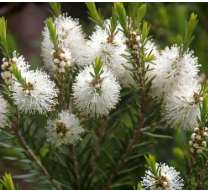
Fig-2- Melaleuca alternifolia
B. Formulation of Herbal Perfume
First, a defined amount of ethyl acetate is added, followed by lavender oil gradually, T.T. oil in smaller amounts, and finally, ethanol, to complete the formulation.
Following completion, the mixture was placed in an airtight container, allowed to react for ten to fifteen days, and then stored in an aerosol canister for later use. (Gurib et al, 2006).
Standard for 20 ml formulation Lavender oil – 8 ml
Ethanol - 8 ml
T.T Oil – 1 ml
Ethyl acetate – Q.s
|
S. No. |
Chemicals |
F1 |
F2 |
F3 |
|
1 |
Ethanol |
8 ml |
9 ml |
8 ml |
|
2 |
Lavender Oil |
8 ml |
8.5 ml |
10 ml |
|
3 |
Ethyl acetate |
3ml |
2 ml |
1.8 ml |
|
4 |
T.T Oil |
1 ml |
0.5 ml |
0.2 ml |
C. Evaluation of Herbal Perfume
1) Physical Evaluation
- Homogeneity :- One millilitre of the formula sample should be taken with a measuring pipette, dropped onto the watch glass, and examined against a black background. (Jiangsu et al, 1977).
- Colour :- One millilitre of the formula sample should be taken with a measuring pipette, dropped onto the watch glass, and examined against a black background.
2) pH Test
The pH test was performed using a pH meter. The perfume preparation is immersed in the electrode. The pH value that appears on the screen is then recorded. At room temperature, the temperature was recorded.
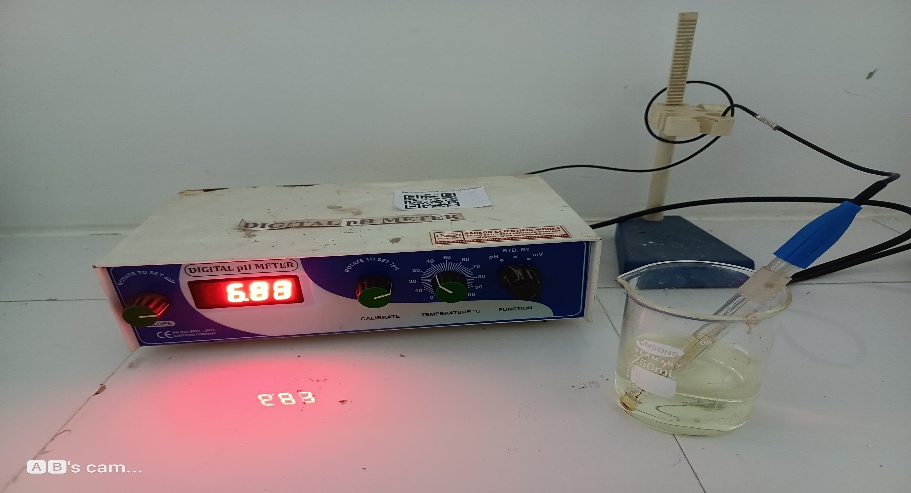
|
S.r |
F1 |
F2 |
F3 |
Limits |
|
PH |
6.2 |
6.5 |
6.4 |
6-8 |
3) Fragrance test
For this, scent blotters, also known as scent test paper, are utilised. A paper is sprayed with perfume to test the scent.
.Steps:-
- Mist the scent down in front of you twice.
- Move the blotter quickly over the smell vapour cloud.
- Wave the blotter across your nose, then take a rapid breath.
- Visit the card often to test its life cycle.
Skin test:
Steps:-
• Apply two mists to the back of your hand, paying attention to the appropriate distance between each mist.
• Let it dry naturally rather than rubbing in the scent.
• Take a whiff of the fragrance without letting your nose touch it. Watch your hand over time to see how it changes. (Ito et al, 2002).
4) Perfume formulation and Hedonic Test
For this study, three fragrances with different proportions of ethanol and essential oils were created. The three perfume samples were made by combining eight aromatic oils, and their stability was tested at 250 and 350 degrees Celsius. (Mahesh et al, 2008).
IV. RESULT & DISCUSSION
1) Physical Evaluation
S. No |
Characteristics |
F1 |
F2 |
F3 |
1 |
Colour |
Clear |
Clear |
Clear |
2 |
Homogeneity |
Good |
Average |
Good |
3 |
Aroma |
Present |
Present |
Present |
4 |
Odour |
Characteristic order |
Characteristic order |
Characteristic order |
2)pH Test
While the pH range for herbal perfume was between 6 and 8, this mixture's pH was between 6.2 and 6.5.
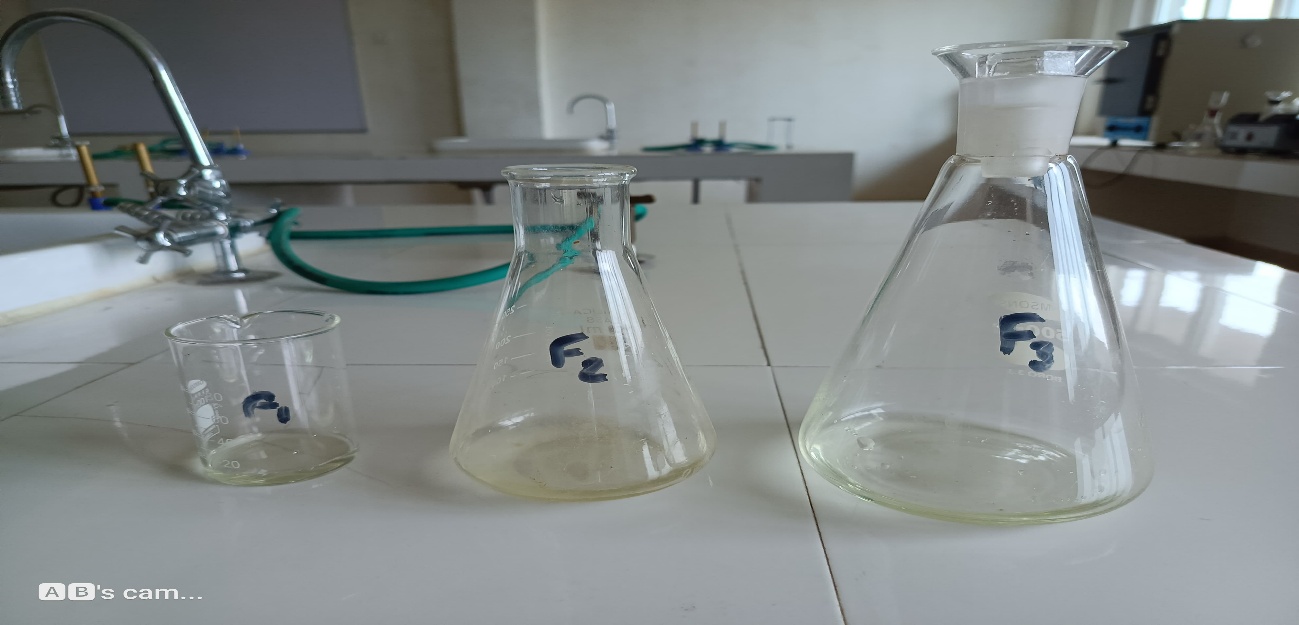
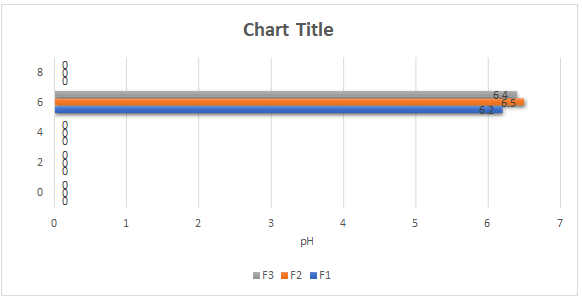
3) Fragrance test
From week 0 to week 6, the entire perfume formula persisted in smelling after four (4) hours, according to the fragrance resistance test. where the produced fragrance is in the range of strong to quite strong. Additionally, it was claimed that the recipes retain scents for around two days.
4) Skin Test
Compatible with all skin types and did not cause any irritation when applied on the skin.
|
|
F1 |
F2 |
F3 |
|
Fragrance |
3.4 hours. |
3.2 hours. |
4.0 hours. |
5) Physical stability Test
There was no separation or change in shape when the formula's overall physical stability was evaluated over a seven-week period at room temperature and at low temperatures. The entire mixture is non-sticky, liquid in texture, and applies effortlessly. Each equation does not show any separation or change; in other words, it has a lovely shape. This is demonstrated by the fact that the shape remains hard, does not melt or soften, and is not watery. Research indicates that over the first eight weeks of the 12-week stability test at room temperature, all three formulations demonstrated consistent findings. However, recipes 2 and 3 displayed a somewhat faded colour shift by the 12th week. (Hara et al, 1995).
|
|
F1 |
F2 |
F3 |
|
Skin Test |
No Irritation |
No Irritation |
No Irritation |
6) Perfume formulation and Hedonic Test
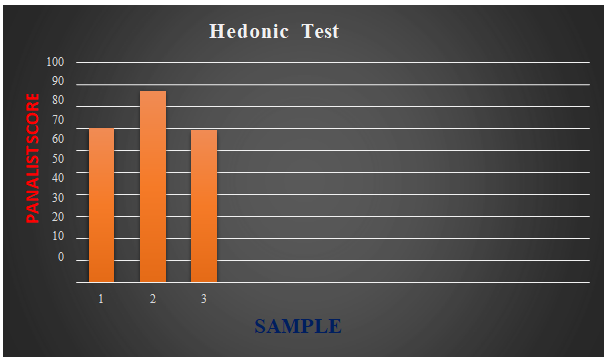 ???????
???????
Conclusion
Given their historical and current social impact, it was unexpected to discover that some of the compounds used in perfumes were derived from plants. Nowadays, this is the primary component of most scents used by both men and women in their colonges and perfumes. Herbal ingredients like tea tree oil and lavender oil, which don\'t irritate skin or prolong the unpleasant effects of commercial fragrances, were used to produce the perfume recipe in this post. It also emits a powerful aroma of lavender and tea tree, which harmonises scents and elevates the user\'s mood. This study showed how valuable plant-based essential oils are as sources of aromatic ingredients for creating local fragrances and how they raise the standard of living for those who generate them. This is an effort to look into the possibility of using plant essential oils to make perfume. The panellists\' reactions to samples of produced perfumes, such as those containing tea tree and Lavandula angustifolia, showed high customer satisfaction with utilising the created smells (F2).
References
[1] Gurib, F. A. (2006). Medicinal plants: traditions of yesterday and drugs of tomorrow. Molecular Aspects of Medicine, 27: 1–93. [2] Hara Y, Luo S, Wickremasinghe L, Yamanishi Y. Food Rev Intern 1995; 11: 409-434. http://en.wikipedia.org/wiki/Jasminum_sambac. [3] Ito Y, Sugimoto A, Kakuda T, Kubota K. J Agric Food Chem 2002; 50: 4878-4884. [4] Jiangsu new medical college. The dictionary of traditional Chinese medicines, p. 297. Shanghai People Press, Shanghai 1977. [5] Joy PP, Thomas J, Mathew S, Skaria BP. Medicinal plant, Naya Prokash, Calcutta, 2001: 449- 632. [6] Kunming institute of botany. Flora Yunnanica Tomus 4, 668. Academica Sinica 1986. [7] Mahesh, B., & Satish, S. (2008). Antimicrobial activity of some important medicinal plant against plant and human pathogens. World journal of agricultural sciences, 4(5): 839-843. Mookherjee B, Trenkle R, Wilson B. Pure Appl Chem 1990; 62: 1357-1364. [8] Tilahun Gisila Abebe, Debre Berhan University, College of Engineering, Department of [9] Chemical Engineering, The International Research Journal of Debre Berhan University, 2021. Yogesh Jagannath Musale, Matoshri Miratai Aher College of Pharmacy, International Journal of Research Publication and Reviews, Vol 4, no 4, pp 5195-5201 April 2023. [10] Brud ws. Formulation and evaluation of fragrance for perfumery cosmetics and related products. K. Tuley de silva. 1995 nov:179. [11] Benan ry, pedro sm, ba-oy rg, pilay tm, sacramento cy, litusquen ba, dimatulac hk, bannawi af. Formulation of solid perfume from locally available chrysanthemum x morifolium (garden chrysanthemum) and theobroma oil. Revolution.;6(16):110-23.
Copyright
Copyright © 2025 Shajeel Ahmad, Vishwajeet Pandey, Shashank Singh, Garima Pandey, Allena , Devratan , Himanshu Singh, Dr. Alok Kumar Shukla. This is an open access article distributed under the Creative Commons Attribution License, which permits unrestricted use, distribution, and reproduction in any medium, provided the original work is properly cited.

Download Paper
Paper Id : IJRASET66590
Publish Date : 2025-01-20
ISSN : 2321-9653
Publisher Name : IJRASET
DOI Link : Click Here
 Submit Paper Online
Submit Paper Online


